Hoops Rumors is checking in on the 2024 offseason for all 30 NBA teams, recapping the summer’s free agent signings, trades, draft picks, departures, and more. We’ll take a look at each team’s offseason moves and consider what might still be coming before the regular season begins. Today, we’re focusing on the Sacramento Kings.
Free agent signings
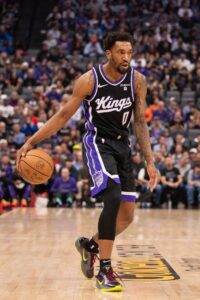 Malik Monk: Four years, $77,975,308. Fourth-year player option. Re-signed using Early Bird rights.
Malik Monk: Four years, $77,975,308. Fourth-year player option. Re-signed using Early Bird rights.- DeMar DeRozan: Three years, $73,710,000. Includes an additional $3MM in unlikely incentives. Third year partially guaranteed ($10MM). Signed using Bird rights and acquired via sign-and-trade from Bulls.
- Alex Len: One year, minimum salary. Re-signed using minimum salary exception. Waived right to veto trade.
- Jordan McLaughlin: One year, minimum salary. Signed using minimum salary exception.
- Orlando Robinson: One year, minimum salary. Partially guaranteed ($500K). Signed using minimum salary exception.
- Boogie Ellis: One year, minimum salary. Non-guaranteed (Exhibit 10). Signed using minimum salary exception.
Trades
- Acquired Jalen McDaniels from the Raptors in exchange for Davion Mitchell, Sasha Vezenkov, the draft rights to Jamal Shead (No. 45 pick), and the Trail Blazers’ 2025 second-round pick.
- Acquired DeMar DeRozan (sign-and-trade) from the Bulls in a three team-trade in exchange for Harrison Barnes (to Spurs), Chris Duarte (to Bulls), the Kings’ 2025 second-round pick (to Bulls), the Kings’ 2028 second-round pick (to Bulls), the right to swap 2031 first-round picks (to Spurs), and cash (to Bulls).
Draft picks
- 1-13: Devin Carter
- Signed to rookie scale contract (four years, $22,141,696).
Two-way signings
Departed/unsigned free agents
- Kessler Edwards (Mavericks)
- Jordan Ford (Aquila Basket Trento)
- JaVale McGee (unsigned)
- Jalen Slawson (Magic)
Salary cap situation
- Operating over the cap ($140.6MM) and below the luxury tax line ($170.8MM).
- Carrying approximately $169.7MM in salary.
- Hard-capped at $178,132,000.
- Full mid-level, bi-annual exceptions available.
- Three traded player exceptions available (largest worth $6,341,464).
The offseason so far
Entering the offseason, there were two notable NBA free agents whose Early Bird rights were considered potentially insufficient to retain them. One of those was Isaiah Hartenstein, who signed a three-year, $87MM contract with the Thunder that the Knicks were unable to match using the Early Bird exception. However, the second of those two free agents, Malik Monk, reached an early deal with the Kings, agreeing to accept Sacramento’s best possible offer well ahead of the start of July.
To be clear, it’s not as if Monk magnanimously accepted a deal way below his market value. His new four-year, $78MM contract is easily the most lucrative of his career, and the $19.5MM annual salary represents an entirely reasonable rate for an effective, offense-first sixth man.
Still, there was a belief that he might’ve been able to secure an even bigger payday on the open market, so the Kings benefited from new NBA rules that permitted them to begin contract talks with Monk immediately after the Finals ended, rather than having to wait until the end of June to open those negotiations.
Having agreed to terms early with Monk, the Kings were able to approach the rest of the summer with the knowledge that their top free agent would be back, and their subsequent roster moves accounted for that. With Monk returning, for instance, Sacramento needed to shed some salary in order to stay out of luxury tax territory, so the club sent Sasha Vezenkov and Davion Mitchell to Toronto, along with two second-round picks, in exchange for Jalen McDaniels.
Vezenkov ended up agreeing to give up his entire $6.66MM salary for the 2024/25 season in order to get out of his contract. If the Kings had known he’d be willing to do that, trading him wouldn’t have been necessary, but it’s possible he only finalized that decision when faced with the prospect of moving to a new country for the second time in two years.
It’s also unfortunate that Sacramento had to give up on Mitchell, a 2021 lottery pick, but his offensive game never really developed and he found himself surpassed on the depth chart last season by undrafted free agent Keon Ellis. While that No. 9 overall pick was a miss for the Kings, they can take some solace in the fact that the teams right behind them in the 2021 draft didn’t do any better — Ziaire Williams, James Bouknight, Joshua Primo, and Chris Duarte were the four players selected right after Mitchell (though Corey Kispert, Alperen Sengun, Trey Murphy, and Jalen Johnson all went later in the top 20).
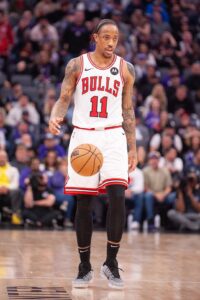 Speaking of Duarte, he was a throw-in salary-matching piece in the Kings’ biggest move of July, a sign-and-trade deal for six-time All-Star DeMar DeRozan. Duarte was packaged with Harrison Barnes (sent to San Antonio), a pair of second-round picks, a 2031 first-round pick swap, and cash in order to bring DeRozan aboard on a three-year contract without adding any salary to the team’s books for 2024/25.
Speaking of Duarte, he was a throw-in salary-matching piece in the Kings’ biggest move of July, a sign-and-trade deal for six-time All-Star DeMar DeRozan. Duarte was packaged with Harrison Barnes (sent to San Antonio), a pair of second-round picks, a 2031 first-round pick swap, and cash in order to bring DeRozan aboard on a three-year contract without adding any salary to the team’s books for 2024/25.
A two-way forward probably would’ve been a better all-around fit for the Kings’ lineup, and it’s not as if Sacramento hadn’t been trying to acquire that sort of player — the team reportedly pursued both OG Anunoby and Pascal Siakam last season before the Raptors traded them elsewhere. But DeRozan was the only impact player available this summer at the price Sacramento was willing to pay, both in terms of the trade package and the contract.
While the Kings will have no shortage of offensive firepower in 2024/25, head coach Mike Brown – who has preached defense since arriving in Sacramento – may not have the personnel for an above-average defense after swapping out Barnes for DeRozan. Domantas Sabonis and De’Aaron Fox aren’t bad on that end of the court, but neither is a top-tier defender; DeRozan and Monk certainly aren’t either. The pressure will be on 2022 lottery pick Keegan Murray to continue making defensive strides and to try to slow down opponents’ top wings while the Kings’ top scorers are simply asked to play solid team D within Brown’s scheme.
The Kings’ other veteran offseason additions were minimum-salary free agent signings — Alex Len will return for a fourth season, with Orlando Robinson joining him in the frontcourt and Jordan McLaughlin signed for backcourt depth. Robinson’s salary isn’t fully guaranteed, so Sacramento could swap him out for a new addition at some point if he doesn’t impress.
In addition to signing McLaughlin, the Kings used their lottery pick to select Devin Carter, a former Providence guard who looked like he might be able to step into an immediate role in the backcourt after a huge year for the Friars in 2023/24. Unfortunately, Carter underwent a shoulder surgery in early July that is expected to sideline him for six months.
It’s possible we’ll see Carter on the court in Sacramento during the season’s second half, but it’s probably unfair for the club to expect anything from him as a rookie, since he wasn’t able to take part in Summer League and won’t be a full participant in training camp or the preseason.
Up next
The Kings are currently carrying just 14 players on standard contracts, with neither Ellis nor Robinson on a fully guaranteed deal, so they have the ability to make some changes at the back of their projected regular season roster, including bringing in a 15th man.
Still, it wouldn’t be a surprise if this is the group that the team sticks with for opening night. Ellis isn’t going anywhere, Robinson has a partial guarantee, and adding a 15th man would push Sacramento’s team salary into luxury tax territory. As long as the roster stays relatively healthy, there’s probably no need to take on another player who won’t see rotation minutes, especially when the club is so close to the tax line.
The Kings’ prime preseason extension candidate is Fox, who is eligible for a new deal worth up to the maximum that would tack on three years to the two left on his current contract. However, reporting in June indicated that the star guard had decided not to sign an extension this offseason, preferring to put off those talks until 2025.
If Sacramento has a disappointing season in 2024/25, Fox’s contract situation might become a cause for concern, but the team shouldn’t be worried about it at this point. The 26-year-old could qualify for a super-max extension if he makes an All-NBA team next spring, which is reason enough for him to wait a year. Even if he misses out on the super-max, Fox would be eligible to sign a slightly longer-term deal beginning next July.
Kevin Huerter is the only other King who is currently extension-eligible. I wouldn’t expect Huerter to get a new deal at this point after he saw his minutes cut back to a career-low 24.4 per game last season.
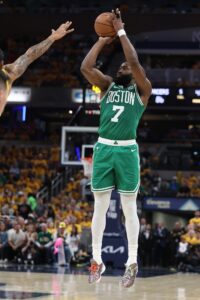 Boston Celtics (58.5 wins):
Boston Celtics (58.5 wins): 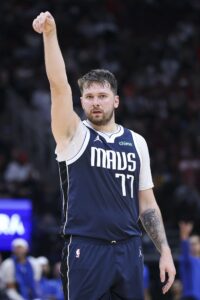 Dallas Mavericks (49.5 wins): 78.0%
Dallas Mavericks (49.5 wins): 78.0%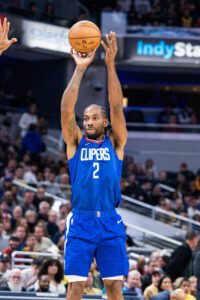 Los Angeles Clippers (39.5 wins):
Los Angeles Clippers (39.5 wins): 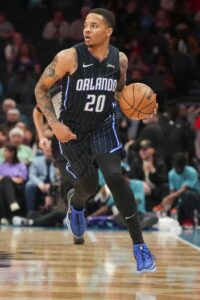 Sure, there were still holes in his game. He rarely attempted long-range shots, converting just 31.0% of his 1.5 three-point attempts per game — and that represented the most accurate mark of his career. While he had a good deal of success on mid-range looks, having a guard who can’t space the floor isn’t ideal for a team’s offense.
Sure, there were still holes in his game. He rarely attempted long-range shots, converting just 31.0% of his 1.5 three-point attempts per game — and that represented the most accurate mark of his career. While he had a good deal of success on mid-range looks, having a guard who can’t space the floor isn’t ideal for a team’s offense.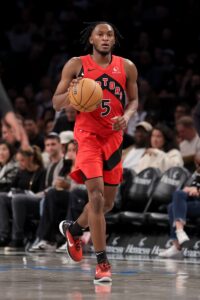
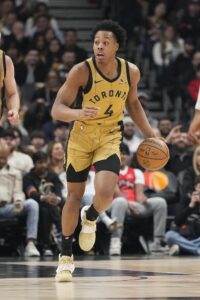 Barnes’ five-year, maximum-salary rookie scale extension is essentially the same deal that his fellow 2021 lottery picks
Barnes’ five-year, maximum-salary rookie scale extension is essentially the same deal that his fellow 2021 lottery picks 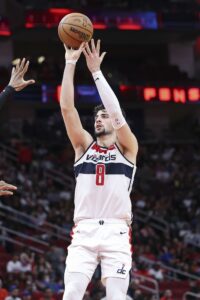 Acquired the Timberwolves’ 2027 second-round pick; either the Pacers’ or Wizards’ 2029 second-round pick (whichever is least favorable); and the Knicks’ 2030 second-round pick from the Knicks in exchange for the draft rights to
Acquired the Timberwolves’ 2027 second-round pick; either the Pacers’ or Wizards’ 2029 second-round pick (whichever is least favorable); and the Knicks’ 2030 second-round pick from the Knicks in exchange for the draft rights to 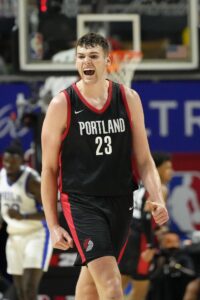 Besides acquiring Avdija, the only other major addition the Blazers made this offseason was drafting center
Besides acquiring Avdija, the only other major addition the Blazers made this offseason was drafting center